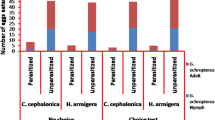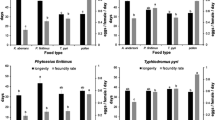Abstract
Two species of Phytoseiidae are found in the same agroecosystem: Typhlodromus exhilaratus prevails in vine plots, while T. phialatus prevails in uncultivated surrounding areas. The objective of the present paper was to investigate whether the poor settlement of T. phialatus in vine plots can be explained by intraguild predation of these two species and/or cannibalism. Predatory abilities of the females on larvae and protonymphs were studied under laboratory conditions. A first experiment was conducted with only conspecific or heterospecific phytoseiid prey, in a second experiment Tetranychus urticae eggs were added to the phytoseiid prey. Oviposition, prey consumption, and escape rates of females were recorded. Oviposition and intraguild predation rates were higher for T. exhilaratus than for T. phialatus. Typhlodromus exhilaratus consumed fewer conspecifics than heterospecific phytoseiids, and oviposited when feeding on both diets. Typhlodromus phialatus consumed equal amounts of con- and heterospecifics. Although these two generalist predators belong to the type III defined by McMurtry and Croft (Annual Review of Entomology 42:291–321, 1997), our results suggest that they have different predation behaviour. However, because these results were obtained in experiments where no choice was given between the two phytoseiid species, they are difficult to link to previous studies conducted on the intraguild predation of the Phytoseiidae. The greater voracity and prolificacy of T. exhilaratus could partially explain the poor settlement of T. phialatus in vineyards and the predominance of T. exhilaratus. However, a full understanding of this phenomenon will require the study of other factors, such as susceptibility to pesticides and micro-climatic conditions, as well as the ability to cope with different food sources and host plants.
Similar content being viewed by others
References
Barbar Z, Tixier M.-S, Kreiter S, Cheval B (2005) Diversity of phytoseiid mites in uncultivated areas adjacent to vineyards: a case study in the south of France. Acarologia 43:145–154
Castagnoli M, Liguori M, Simoni S (2002) Inter-specific predation and cannibalism in four phytoseiid species of the Mediterranean area (Acari: Phytoseiidae). In: Bernini F, Nannelli R, Nuzzaci G, de Lillo E (eds) Acarid Phylogeny and Evolution: Adaptation in mites and ticks. Kluwer Academic Publishers, The Netherlands, 341–349
Croft BA, Kim SS, Kim DI (1996) Intra and interspecific predation on four life stage groups by adult females of Metaseiulus occidentalis, Typhlodromus pyri, Neoseiulus fallacis and Amblyseius andersoni. Exp Appl Acarol 20:435–444
Dong Q, Polis GA (1992) The dynamics of cannibalistic populations: a foraging perspective In: Elgar MA, Crespi BJ (eds) Cannibalism: Ecology and Evolution among diverse Taxa. Oxford University Press, UK, 13–37
Ferragut F, Garcia-Mari F, Costa-Comelles J, Laborda R (1987) Influence of food and temperature on development and oviposition of Euseius stipulatus and Typhlodromus phialatus (Acari: Phytoseiidae). Exp Appl Acarol 3:317–329
McCann K, Hasting A, Huxel GR (1998) Weak trophic interactions and balance of nature. Nature 395:794–798
McMurtry JA, Croft BA (1997) Life-styles of Phytoseiid mites and their roles in biological control. Annu Rev Entomol 42:291–321
McMurtry JA, Scriven GT (1962) The use of agar media in transporting and rearing phytoseiid mites. J Econ Entomol 55:412–414
Pels B, Sabelis MW (1999) Local dynamics, overexploitation and predator dispersal. Oikos 86:573–583
Polis GA (1981) The evolution and dynamics of intraspecific predation. Annu Rev Ecol Syst 12:225–251
Polis GA, Myers CA, Holt RD (1989) The ecology and evolution of intraguild predation: potential competitors that eat each other. Annu Rev Ecol Syst 20:297–330
Scherrer B (1984) Biostatistique. Morin G (ed) 850 pp
Schausberger P (1997) Inter- and intraspecific predation on immatures by adult females in Euseius finlandicus, Typhlodromus pyri and Kampimodrous aberrans (Acari: Phytoseiidae). Exp Appl Acarol 21:131–150
Schausberger P (1999) Predation preference of Typhlodromus pyri and Kampimodromus aberrans (Acari: Phtyoseiidae) when offered con- and heterospecific immature life stages. Exp Appl Acarol 23:389–398
Schausberger P (2003) Cannibalism among phytoseiid mites: a review. Exp Appl Acarol 29:173–191
Schausberger P, Croft BA (1999) Predation on and discrimination between con- and heterospecific eggs among specialist and generalist phytoseiid mites (Acari: Phytoseiidae). Environ Entomol 28(3):523–528
Schausberger P, Croft BA, 2000a. Cannibalism and intraguild predation among phytoseiid mites: are aggressiveness and prey preference related to diet specialisation? Exp Appl Acarol 24:709–725
Schausberger P, Croft BA, 2000b. Nutritional benefits of intraguild predation and cannibalism among generalist and specialist predaceous mites. Ecol Entomol 25:473–480
Tixier M-S, Kreiter S, Barbar Z, Ragusa S, Cheval B (2006a) The status of two cryptic species: Typhlodromus exhilaratus Ragusa and Typhlodromus phialatus Athias-Henriot (Acari: Phytoseiidae): consequences for taxonomy. Zoologica scripta 35:115–122
Tixier M-S, Kreiter S, Cheval B, Guichou S, Auger P, Bonafos R (2006b) Immigration of phytoseiid mites from surrounding uncultivated areas into a newly planted vineyard. Exp Appl Acarol 39:227–242
Sabelis MW, (1985) Development. In: Helle W, Sabelis MW (eds) Spider Mites: their biology, natural enemies and control, vol 1B. Elsevier pub. 43–53
Statistica® (2001) Version 6.0. Statsoft Inc. USA
Walzer A, Schausberger P (1999a) Cannibalism and interspecific predation in the phytoseiid mites Phytoseiulus persimilis and Neoseiulus californicus: predation rates and effects on reproduction and juvenile development. BioControl 43:457–468
Walzer A, Schausberger P (1999b) Predation preferences and discrimination between con- and heterospecific prey by the phytoseiid mites Phytoseiulus persimilis and Neoseiulus californicus. BioControl 43:469–478
Acknowledgements
We are very grateful to the CONSEIL GÉNÉRAL DE L’HÉRAULT for its financial support. This study is part of the project, “Programme de Recherche Intégrée en AgroforesTerie (PIRAT)”, coordinated by INRA Montpellier for 1999–2007. We would also like to thank Julien Beuzelin for his help during the writing and for his comment on the first version of this manuscript, and Peter Schausberger for useful comments on an early version of the manuscript.
Author information
Authors and Affiliations
Corresponding author
Rights and permissions
About this article
Cite this article
Meszaros, A., Tixier, MS., Cheval, B. et al. Cannibalism and intraguild predation in Typhlodromus exhilaratus and T. phialatus (Acari: Phytoseiidae) under laboratory conditions. Exp Appl Acarol 41, 37–43 (2007). https://doi.org/10.1007/s10493-006-9046-x
Received:
Accepted:
Published:
Issue Date:
DOI: https://doi.org/10.1007/s10493-006-9046-x




